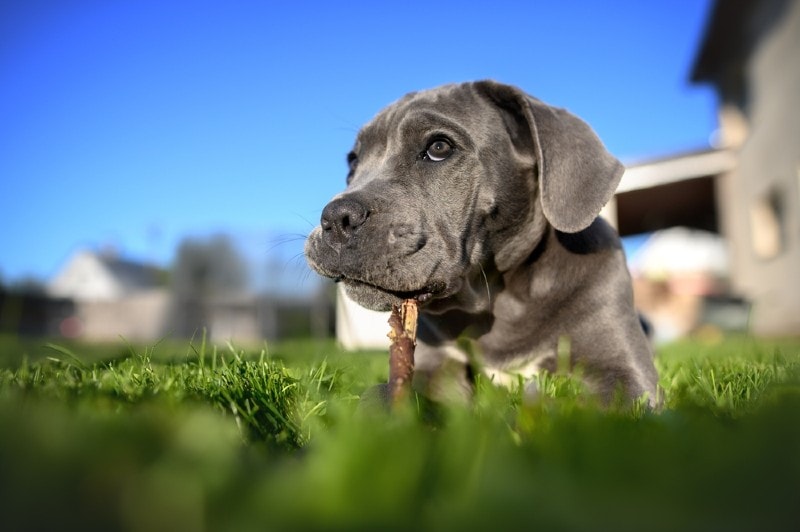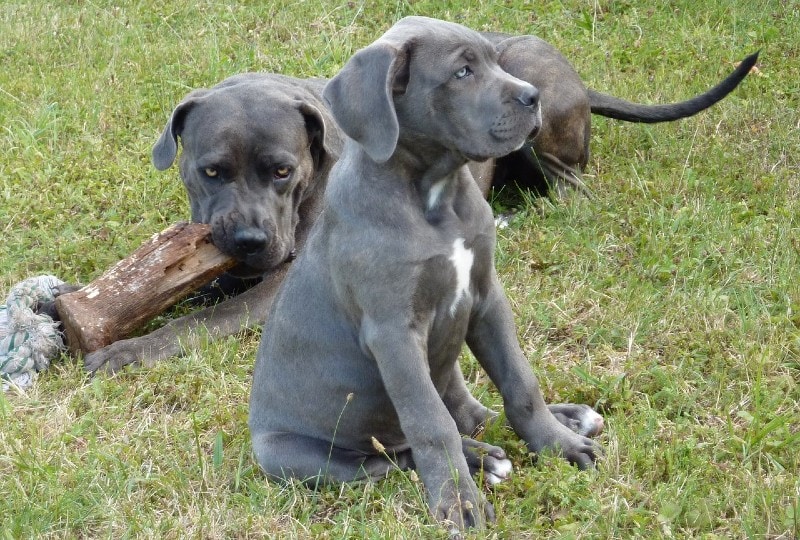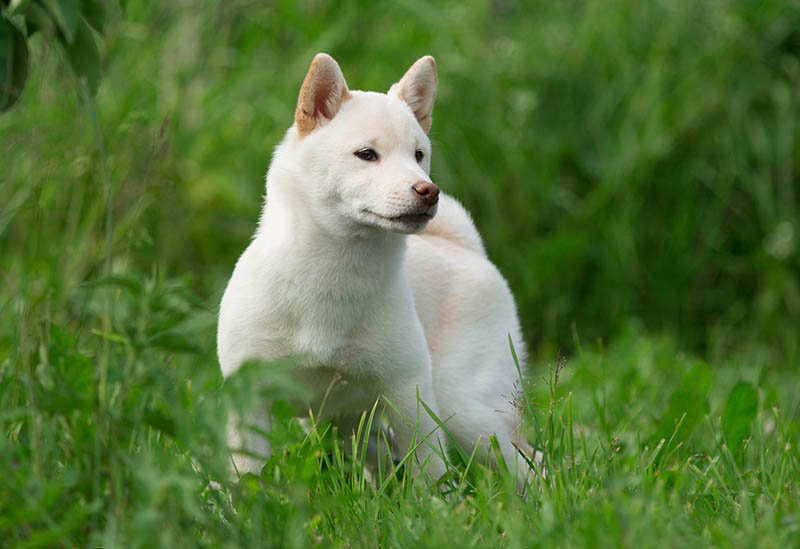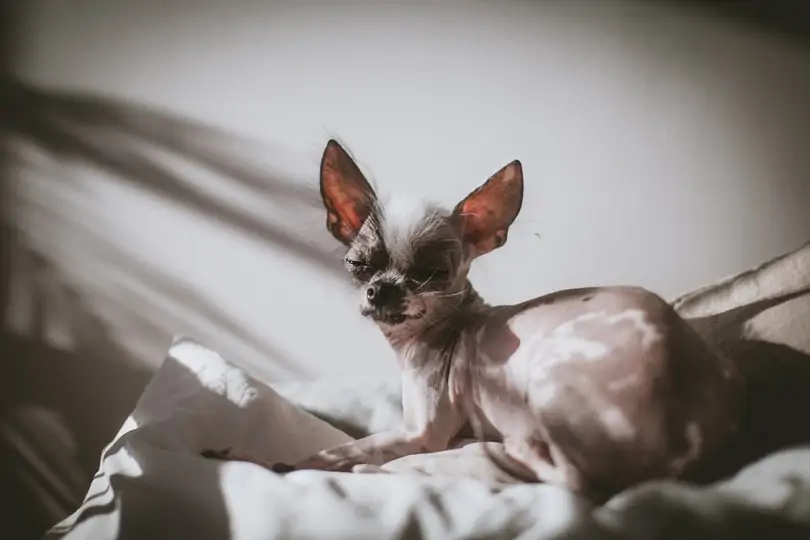Blue Cane Corso: Facts, Origin & History (with Pictures)
Updated on

Click to Skip Ahead
The Cane Corso is an Italian mastiff breed that is known for its confidence and loyalty. This immensely powerful dog was born and bred to be a guardian and its popularity has soared in recent years. One of the most sought-after coat colors of this beloved breed is the blue coat color.
The blue Cane Corso isn’t really blue, though. They are considered gray by breed standards and this coat color is the result of the recessive dilute gene, which causes diluted levels of pigmentation in the fur. In this article, we’ll learn more about these impressive animals and dive into their origins and history.
The Earliest Records of the Blue Cane Corso Breed in History
The Cane Corso is believed to have been descended from Greek Molossus dogs, which are now extinct. These dogs were bred by the Greeks as guard dogs and were taken into Italy when the Greek Islands were overrun by the Roman Empire.
Once in Italy, it is believed the Greek Mollosus dogs were bred with native Italian breeds, ultimately resulting in both the Cane Corso and their larger relative, the Neopolitan Mastiff. The ancestors of the breed were used as Roman war dogs but after the collapse of the Roman Empire, they were used for other purposes.
The Cane Corso, referred to as Corsi, made excellent guard dogs for the Italian people. They were also used as boar hunters and were very popular among farmers for guarding their livestock and hen houses. However, the years of constant upheaval in the Italian peninsula during this time resulted in a massive decline in the breed’s numbers.

How the Blue Cane Corso Gained Popularity
This breed may date back to Ancient Rome but it nearly went extinct during the mid-20th century. After two world wars and changes in farming practices, the Cane Corso barely survived.
It wasn’t until the 1970s that they began making a comeback when preservation efforts were put into place and breed enthusiasts worked tirelessly to locate the few that were left. Selective breeding of the remaining dogs took place and kept the Cane Corso breed alive.
An official breed society, Società Amatori Cane Corso, was formed in 1983. They eventually made their way through Europe and finally reached the United States in 1988. Their numbers and popularity began to increase over time, especially in the early 2000s.
The Cane Corso is now a very well-known breed that is often kept as a protector and beloved family pet. As of 2021, the Cane Corso ranked 21 on the AKC’s most popular dog breed list. The beloved blue (gray) Cane Corso is just one of the several coat colors featured in this stunning mastiff.
Formal Recognition of the Blue Cane Corso
Unlike other breeds that date back to ancient times, the Cane Corso struggled with official recognition due to their population decline. They have yet to be recognized by the Kennel Club of the United Kingdom, but their timeline of official recognition goes as follows:
- 1983 – Corsi enthusiasts formed the Società Amatori Cane Corso, their first breed society.
- 1994 – Ente Nazionale della Cinofilia Italiana (ENCI) officially recognized the Cane Corso.
- 1996 – The FCI (Fédération Cynologique Internationale) accepts the Cane Corso on a provisional basis.
- 2007 – The Cane Corso breed receives full recognition from the World Canine Organization.
- 2008 – The United Kennel Club recognizes the Cane Corso.
- 2010 – The Cane Corso receives official recognition from The American Kennel Club.
Top 10 Unique Facts About the Cane Corso
1. “Blue” Cane Corsos Produce the Same Color as Black Cane Corsos
As we’ve mentioned, the blue Cane Corso is technically a gray dog. They produce the same type of pigment found in the black version of the breed, which is called eumelanin. These dogs possess the recessive dilute gene that causes the black pigment to become diluted, which results in their varying shades of gray. While this may be a recessive trait, it’s not a rare one thanks to selective breeding.
2. Their Eye Color Varies
Cane Corsos are born with dark blue eyes that will eventually change to varying shades of brown, amber, or gold. Gray Cane Corsos are well known for having striking, light amber-colored eyes that stand out exceptionally against their coat color.
3. Most People Pronounce the Name Wrong
If you pronounce the cane in Cane Corso like “kayn kor-so,” you’re pronouncing it incorrectly. The actual pronunciation of the breed’s name is “kah-nay kor-so.”
4. The Cane Corso Needs a Firm Leader
The Cane Corso is an exceptionally intelligent breed that will require consistent training throughout their lives. While they are generally eager to please, they are large, powerful, willful, and can have a bit of an independent streak. They require a firm and confident leader that makes their expectations known.
5. Cane Corso has Seven Recognized Breed Colors
The Cane Corso has seven recognized coat colors according to AKC breed standards, all of which hold their own unique beauty. In addition to that, they can either have the marking of a gray mask or a black mask. Here’s a peek at the coat colors that fall within the standard:
- Black
- Fawn
- Gray
- Gray Brindle
- Red
- Black Brindle
- Chestnut Brindle
6. Their Name Translates to “Bodyguard Dog”
The name Cane Corso is derived from the Latin term meaning “bodyguard-dog,” which makes sense considering these dogs are fierce protectors and were born and bred for this purpose. Cane is Italian for dog and “cohors” is the Latin term for “guardian.”
7. Cane Corsos Aren’t Couch Potatoes
This breed is a working dog that does best when they have a job to do. Big, lovable breeds like mastiffs are typically associated with being snuggly couch potatoes that are perfectly fine sleeping the day away. While the Cane Corso may be no stranger to the couch after a hard day’s work, they should be provided lots of exercise and mental stimulation to meet their needs.
8. Several Big Name Celebrities Have Cane Corsos
Several celebrities share their homes with a Cane Corso. This list includes Sylvester Stallone, Vin Diesel, Quentin Tarantino, Sherri Shepherd, and NFL stars Patrick Mahomes and Odell Beckham Jr.
9. They Are Considered One of the Most Formidable Dog Breeds
The Cane Corso is among the list of the dog breeds that inspire respect and fear. Not only are they massive in size, but they have large heads, muscular bodies, and a fierce protective instinct that is not to be messed with. They are often sought after as protection dogs because of these traits and their keen intelligence.
10. There’s a Plural Term for Cane Corso
If you have one Cane Corso it’s just considered a Cane Corso, but if you have two or more then you have Cani Corsi.
Does the Blue Cane Corso Make a Good Pet?
The blue Cane Corso can certainly make a great pet under the right circumstances. These dogs are impressively large, powerful, and intense and are not going to be well suited for everyone. These dogs need to be socialized early to get used to other people, animals, and a variety of settings.
They are incredibly loyal and loving with their family but tend to be more aloof and wary of strangers. They have a protective nature and, considering their strength, an owner should be firm and have full control of this breed, which means consistent, proper training is imperative.
Their size alone makes them best suited for families with older children but they can make excellent family pets. They tend to be a bit goofy, have silly vocals, and will go out of their way to get the attention they want. Did we mention they may snore a lot?
Cane Corsos with heavier jowls will naturally slobber a lot. They have a short, double-layered coat that will shed all year round, but especially during the springtime. They have a shorter-than-average lifespan of 9 to 12 years, which is typical of dogs this size.
They are generally healthy but they are predisposed to certain genetic health conditions including hip and elbow dysplasia, idiopathic epilepsy, and eyelid abnormalities. Anyone interested in a Cane Corso should do their research and only purchase from a reputable breeder who knows the breed and does the proper health testing.
Conclusion
The blue Cane Corso is actually the gray version of the breed. This coloration is the result of the recessive dilute gene that makes their coat varying shades of gray. This is a very powerful, strong breed with a loving but willful disposition. They may not be well suited for everyone but they have the potential to make excellent companions and protectors for owners that are compatible with their needs.
- See also: Best Dog Shampoos – Reviews & Top Picks
Featured Image Credit: otsphoto, Shutterstock













